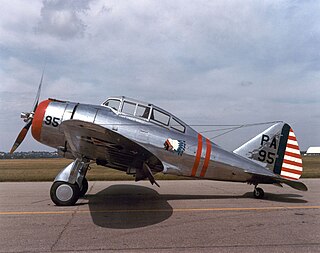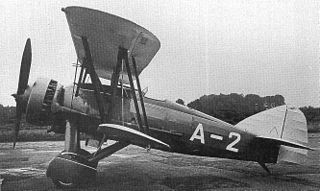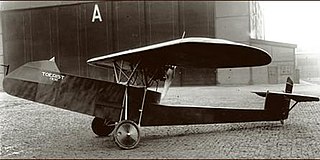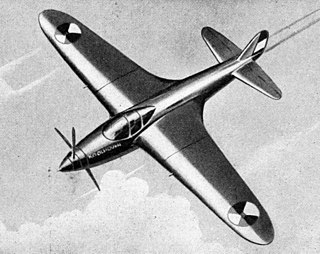
The Curtiss P-36 Hawk, also known as the Curtiss Hawk Model 75, is an American-designed and built fighter aircraft of the 1930s and 40s. A contemporary of the Hawker Hurricane and Messerschmitt Bf 109, it was one of the first of a new generation of combat aircraft—a sleek monoplane design with a retractable undercarriage making extensive use of metal in its construction.

The Seversky P-35 is an American fighter aircraft built by the Seversky Aircraft Company in the late 1930s. A contemporary of the Hawker Hurricane and Messerschmitt Bf 109, the P-35 was the first single-seat fighter in United States Army Air Corps to feature all-metal construction, retractable landing gear, and an enclosed cockpit.

The Seversky XP-41 was a fighter aircraft built in the United States in 1939. A single prototype was modified from the last production Seversky P-35 by adding a new streamlined canopy, a Pratt & Whitney R-1830-19 engine with a two-speed supercharger, and revised landing gear. The XP-41 first flew in March 1939. The aircraft was developed in parallel with the P-43 Lancer, and work was stopped when the USAAC showed a preference for the latter.

The Koolhoven F.K.58 was a single engine, interceptor-fighter aircraft designed and mainly manufactured by N V Koolhoven in the Netherlands under contract by France. Intended for Armée de l'Air use, the F.K.58 saw limited service in the Battle of France.

The Vought FU was a biplane fighter aircraft of the United States Navy in service during the late 1920s.

Koolhoven F.K.52 was a Dutch-designed, two-seat reconnaissance-fighter biplane, which was developed in the 1930s by Koolhoven. The aircraft was equipped with an enclosed cockpit and single-strut landing gear. Only six aircraft were produced. The aircraft saw some service in the Finnish Air Force.

IVL Haukka were a series of Finnish biplane fighters designed by Kurt Berger at IVL in 1927. "Haukka" is Finnish for "Hawk".

The Armstrong Whitworth A.W.16 was a British single-engine biplane fighter aircraft designed and built by Armstrong Whitworth Aircraft. A number were sold to the Chinese Kwangsi Air Force.

The Armstrong Whitworth F.K.10 was a British two-seat quadruplane fighter aircraft built by Armstrong Whitworth during the First World War. While it was ordered in small numbers for the Royal Flying Corps and Royal Naval Air Service, it was not used operationally. It is one of the few quadruplane aircraft to reach production.

The BAT F.K.23 Bantam was a British single-seat fighter biplane produced by British Aerial Transport Company Limited of London during World War I.

The Letov Š-28 was a Czechoslovak single-engined, two-seat reconnaissance aircraft. It was manufactured by Letov Kbely in a number of versions with different powerplants. The most important version was the Š-328, which was produced in relatively high quantities.

The Koolhoven F.K.51 was a 1930s Dutch two-seat basic training biplane built by the Koolhoven Company.

The Caproni Vizzola F.5 was an Italian fighter aircraft that was built by Caproni. It was a single-seat, low-wing cantilever monoplane with retractable landing gear.

The Curtiss XP-31 Swift was a 1930s American experimental monoplane fighter built by Curtiss for the United States Army Air Corps.

The Koolhoven F.K.30 Toerist was a small sport aircraft built in the Netherlands in 1927, intended for use by aeroclubs. The fuselage carried the pilot and one passenger in tandem in a bathtub-like open cockpit. The cantilever parasol wing was mounted above and behind them, with the main wheels of the fixed undercarriage directly below the wing, at the sides of the fuselage. The engine, driving a pusher propeller, was mounted on the aircraft centerline at the aft portion of the wing. The conventional empennage was carried on a boom extending below the propeller arc. The wing, including engine, was designed so that it could be pivoted 90° while on the ground, allowing the aircraft to be stored and transported more easily.

The Koolhoven F.K.55 was a Dutch fighter prototype of the 1930s, which did not progress beyond the prototype stage.

The BAT F.K.25 Basilisk was a prototype British fighter aircraft of the First World War. A single engined biplane intended to meet a requirement to replace the Sopwith Snipe, the Basilisk was unsuccessful, only three being built.

The Caproni Ca.70 was a two-seat night fighter and ground attack biplane produced in Italy in 1925. It was the only Italian aircraft designed from the outset as a night fighter.

The NVI F.K.35 or Koolhoven F.K.35 was a two-seat fighter aircraft built in the Netherlands during 1926. It was completed and exhibited but, through a combination of ground accident and financial problems, never flown.

The SNCAC NC-600 was a prototype French twin-engined long-range fighter aircraft, developed by SNCAC from the earlier Hanriot H.220 fighter. The type never entered service, with development being ended by the French surrender in June 1940.





















